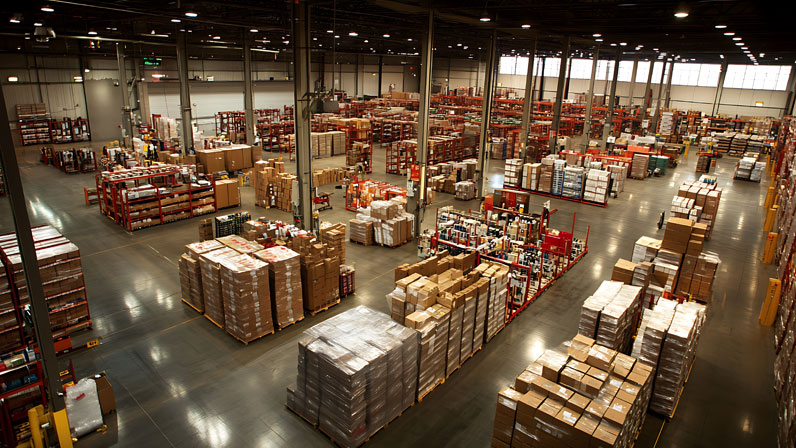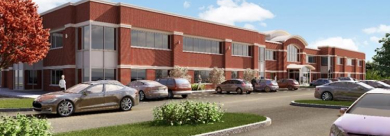Smart warehouse storage isn’t just about stacking shelves—it’s about stacking up savings and efficiency. In today’s competitive ecommerce and B2B markets, how you store your inventory can directly impact your profitability. From choosing the right systems to leveraging advanced tech, there are plenty of ways to streamline operations and boost productivity. This guide walks through storage strategies that save space and money, helping you make smarter decisions for your business growth.
Highlights
- Efficient warehouse storage solutions reduce operational costs and increase productivity.
- Strategic storage types like pallet racking, shelving, mezzanines, and automation can transform workflows.
- A well-optimized layout improves order fulfillment and minimizes wasted space.
- Technology like WMS and IoT boosts inventory accuracy and workflow efficiency.
- Outsourcing to a 3PL warehouse can provide scalable, cost-effective warehousing support.
- Sustainable practices and smart cost-saving tips future-proof your warehousing operations.
In today's fast-paced ecommerce world, efficient warehouse storage solutions are more crucial than ever. Businesses face the challenge of managing inventory while keeping costs low.
The right storage solutions can transform your warehouse operations. They can enhance efficiency and save money.
From advanced warehouse management systems to innovative storage designs, options abound. Each solution offers unique benefits tailored to specific business needs.
Understanding these options is key to optimizing your warehouse. It ensures you meet the demands of multichannel marketing and distribution.
This guide explores practical strategies to streamline your warehousing. It provides insights into cost-effective solutions that boost productivity.
Discover how to leverage technology and smart practices. Future-proof your warehouse for growth and success.
Why Smart Warehouse Storage Solutions Matter for Your Bottom Line
Smart warehouse storage solutions directly impact your bottom line. They optimize space, enhance efficiency, and reduce operational costs.
Efficient storage leads to quicker order fulfillment. This improves customer satisfaction and can boost your sales.
Not all storage solutions fit every business. Select those aligning with your specific needs and objectives.
Key benefits include:
- Reduced storage costs
- Increased productivity
- Enhanced inventory accuracy
- Streamlined operations
Implementing innovative storage strategies can maintain a competitive edge. It allows quick adaptation to market changes and customer demands.
The right solutions create a seamless flow of goods. This minimizes delays, ensuring smooth operations.
Understanding their significance is crucial for long- term success. Consider them an investment, not an expense.

Assessing Your Current Warehouse and Inventory Management
Before implementing new warehouse storage solutions, assess your current system. Identify inefficiencies and areas for improvement.
A thorough evaluation reveals bottlenecks impacting productivity and costs. It forms the basis for strategic enhancements.
Key assessment components include:
- Current layout and space utilization
- Accuracy of inventory data
- Order fulfillment speed
- Staff productivity
Gather insights from team members. Their on-the-ground knowledge is invaluable for understanding practical challenges.
Regular audits and reviews are crucial. They ensure your systems align with evolving business needs.
By comprehensively assessing existing operations, you can tailor solutions effectively. This targeted approach maximizes benefits, ensuring every change adds measurable value.
Types of Warehouse Storage Solutions: Pros, Cons, and Cost Impact
Choosing the right storage solutions is crucial for efficient warehouse management. Different options offer distinct benefits and drawbacks.
Pallet racking systems are popular for their versatility. They optimize floor space and increase accessibility for forklifts.
Shelving and modular storage offer adaptability. They are ideal for smaller items and can be easily reconfigured.
Mezzanines and vertical solutions make use of unused vertical space. They double storage capacity without expanding your warehouse footprint.
Automated and smart storage systems use technology to enhance efficiency. They're perfect for high-volume operations but require significant upfront investment.
Pros of various solutions:
- Maximize space efficiency
- Improve inventory access
- Enhance workflow
Cons to consider:
- Initial setup costs
- Training requirements
- Maintenance needs
Evaluating each system's cost impact is vital. Weigh initial investments against potential savings in efficiency and space utilization. The right choice should balance functionality with cost-effectiveness, driving business growth in the long term.
Pallet Racking Systems
Pallet racking systems are ideal for diverse product sizes. They're adjustable and enhance floor space.
Pros:
- Space-efficient
- Cost-effective
- Compatible with forklifts
Cons:
- Requires installation
- Limited to palletized goods
Consider pallet racking for high-density storage needs. It's versatile and fits many industries, streamlining access and inventory control.
Shelving and Modular Storage
Shelving and modular storage systems offer flexibility for non-palletized items. They're easy to assemble and customize.
Pros:
- Adaptive design
- Simple setup
- Cost-effective
Cons:
- Limited heavy item support
- Regular maintenance
Use shelving for small, varied products requiring easy access. It's an excellent solution for dynamic inventory environments.

Mezzanines and Vertical Solutions
Mezzanines utilize overhead space effectively, doubling storage without enlarging the footprint. They offer cost savings in expanding warehouse capacity.
Pros:
- Increases storage space
- Cost-saving on expansion
- Customizable configurations
Cons:
- Structural requirements
- Potential high initial cost
Consider mezzanines when expanding horizontally is not feasible. They provide additional levels for storage, improving space utility.
Automated and Smart Storage Systems
Automated solutions streamline operations with technology, reducing manual labor and errors. Suitable for large-scale facilities focused on efficiency.
Pros:
- Higher accuracy
- Reduced labor costs
- Efficient for large volumes
Cons:
- High upfront investment
- Requires technical expertise
Opt for automation if you handle extensive inventory and want precise control. These systems provide long-term savings through improved accuracy and reduced manpower.
Optimizing Warehouse Layout for Maximum Efficiency
An efficient warehouse layout maximizes space and enhances productivity. Start by analyzing current workflows and identifying bottlenecks.
Consider organizing the warehouse to minimize travel time. Position high-demand products close to shipping areas.
Using logical zoning can also boost efficiency. Group similar items together for easier picking and restocking.
Key layout optimization strategies:
- Map workflow paths
- Identify high-traffic areas
- Balance space and accessibility
Adjust shelving units to fit product dimensions, ensuring no space is wasted. This minimizes the distance employees travel.
Regularly review and adjust layouts based on data analytics. Changing consumer demands and product mixes can influence space requirements.
Finally, a well-optimized layout reduces errors and speeds up operations. This optimization leads to significant cost savings and increased throughput.

Leveraging Technology: WMS, IoT, and Data Analytics
Leveraging technology in warehousing is a game-changer for efficiency. A robust Warehouse Management System (WMS) streamlines tasks and inventory management effectively.
Incorporating Internet of Things (IoT) devices allows real-time tracking of goods. This enhances accuracy in inventory levels and reduces errors.
Data analytics provides insights into operational patterns and consumer demand trends. By analyzing this data, you can optimize stock levels and forecast needs.
Key tech benefits:
- Enhanced inventory accuracy
- Improved workflow efficiency
- Better demand forecasting
Implementing these technologies leads to smarter decision-making. This results in enhanced customer satisfaction and reduced operational costs.
Staying current with tech advances ensures your warehouse remains competitive. It helps future-proof operations by adapting to an ever-evolving market landscape.
3PL Warehouse Management: When and Why to Outsource
Deciding when to outsource warehousing is crucial. For many, the right moment is when costs or complexity rise.
Outsourcing to a 3PL provider can offer flexibility and scalability. This is ideal for businesses experiencing rapid growth or seasonal spikes.
3PL partners also bring expertise in warehousing and distribution. They often have access to advanced technologies and infrastructure.
Consider outsourcing if:
- Demand fluctuates significantly
- Expansion is hindered by lack of space
- In-house costs become prohibitive
The benefits of 3PL include improved efficiency and reduced capital investment. It's a strategic choice that can free up resources for core business activities.
Ultimately, it's a balance between control and convenience. Analyze your business needs carefully to find the right fit.
Sustainable and Cost-Saving Practices in Warehousing
Warehouses that embrace sustainability can also enjoy cost savings. Adopting energy-efficient practices leads to lower utility bills.
Simple changes, like using LED lighting, can make a big difference. They reduce energy consumption and require less maintenance.
Recycling programs not only minimize waste but also lower disposal costs. Sustainable warehousing prioritizes both environmental benefits and financial gains.
Sustainable practices to consider:
- Implementing solar energy systems
- Using energy-efficient HVAC units
- Prioritizing waste reduction and recycling
Incorporating these strategies contributes to a leaner, greener operation. It’s a smart move for the planet and the bottom line.
Actionable Tips to Reduce Costs and Boost Productivity
Implementing effective practices in your warehouse can cut costs significantly. This also enhances productivity, boosting overall output.
Focus on streamlining inventory management. Accurate stock levels prevent overstocking and shortages, reducing wasted resources.
Training employees boosts their efficiency and safety. A well-trained team can handle tasks faster, lowering error rates.
Consider these cost-cutting tips:
- Automate routine processes
- Regularly audit inventory
- Optimize warehouse layout for flow
Adopting these strategies empowers your warehouse to operate efficiently. It strikes the perfect balance between cost control and productivity.

Choosing the Right Storage Solution for Your Business
Selecting the right storage solution is critical for success. It hinges on understanding your specific needs and business model.
Evaluate your inventory type, storage space, and budget constraints. Tailor your choice to align with these factors for optimal results.
Considerations for choosing a storage solution:
- Scalability for growth
- Compatibility with current systems
- Cost-effectiveness
These factors ensure your storage solution supports operational efficiency. They also provide room for future expansion without strain.
Future-Proofing Your Warehouse for Growth
To thrive in the dynamic market, adapt your warehouse storage solutions continuously. Incorporate new technologies and innovative practices to maintain competitiveness.
Ensure your warehouse is adaptable to changes in demand and inventory profiles. Staying agile can help your business grow sustainably and efficiently.
How Jillamy Can Help
At Jillamy, we recognize that warehouse storage solutions go beyond mere racks and shelves—they form the backbone of operational efficiency. Our 3PL warehouse services are designed to cater to your unique inventory and fulfillment requirements, whether you're rapidly expanding or handling seasonal fluctuations in volume.
With multiple warehouse locations, expert warehouse and inventory management, and flexible solutions from kitting to packaging, we’re equipped to optimize your storage and reduce overhead. Need a smarter way to manage space, cut costs, and keep products moving? We’ve got you covered.
Contact Jillamy today to discover how our warehouse storage solutions can support your growth and streamline your operations.


